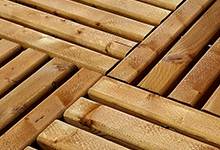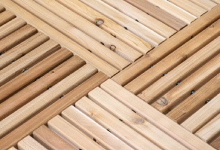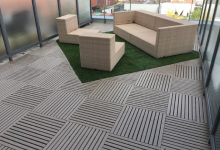Would you like to browse our deck tile products and accessories?

- By: Designer Deck
- Tags: Is the Tile Easily Removed
- Category: Uncategorized
- 0 comment
Is the Tile Easily Removed? Yes, tiles are easily removed.
For centuries, tiles have remained a favored option for flooring, walls, and backsplashes. Their enduring popularity is owed to their strength, adaptability, and visual charm, making them a choice appreciated by many across generations.
However, one common concern among homeowners and interior designers alike is the ease of removing tiles once they are installed. Whether you are planning a renovation or just considering your options, understanding the factors that determine how easily tiles can be removed is crucial.
Factors to Determine How Easily Tiles Can Be Removed
The Adhesive Factor
A crucial factor in tile removal is the kind of adhesive applied during installation. Traditional cement-based adhesives create a strong bond, making it difficult to remove tiles without damaging them or the underlying surface.
On the other hand, modern adhesive technologies like peel-and-stick or mastic adhesives offer more flexibility, allowing for easier tile removal. It’s essential to know the type of adhesive used in your installation to assess the ease of removal.
Tile Material Matters
The material of the tile itself significantly impacts how easy it is to remove. Ceramic and porcelain tiles are generally more challenging to remove due to their hardness and density.
Natural stone tiles, such as granite or slate, can also pose a challenge because of their weight and the strong adhesive often required for installation. In contrast, glass or mosaic tiles, which are often thinner and lighter, can be relatively easier to remove.
Substrate and Surface Preparation
Proper surface preparation and choice of substrate play a crucial role in the ease of tile removal. Tiles adhered to a smooth, clean surface are generally more challenging to remove than those installed on a rough or uneven substrate.
Additionally, tiles installed on drywall or plywood might come off more easily compared to those on concrete or cement backer boards.
Grout and Its Impact
Grout is another factor to consider when evaluating the ease of tile removal. Epoxy grout, prized for its strong resistance against stains and moisture, forms a sturdy connection between tiles due to its exceptional durability. While this is excellent for longevity, it also means that tiles set with epoxy grout can be challenging to remove. Cementitious grout, while not as strong, provides a bit more flexibility, making tile removal somewhat easier.
Professional Installation vs. DIY
The expertise of the person installing the tiles is crucial. A professionally installed tile job is likely to be more secure, making it harder to remove without professional help. DIY installations, while potentially easier to remove due to the lack of industrial-strength adhesives, may lack the precision and stability of professional work.
Points to Consider Regarding the Ease of Removing Tiles

1. Tile Size and Pattern:
- Large Tiles: Larger tiles cover more surface area with fewer grout lines, making them relatively harder to remove.
- Complex Patterns: Tiles arranged in intricate patterns might require meticulous removal to preserve the design, adding to the complexity.
2. Underfloor Heating Systems:
- If your tiles are installed over a radiant underfloor heating system, removal can be more challenging due to the presence of additional elements beneath the tiles.
3. Waterproofing and Sealants:
- Tiles in wet areas like bathrooms or kitchens are often sealed to prevent water damage. Sealants enhance tile adhesion but can complicate removal efforts.
4. Age of the Installation:
- Older tile installations might have degraded adhesive, making them slightly easier to remove compared to freshly installed tiles with robust adhesion.
5. Preliminary Testing:
- Before attempting tile removal, conduct a small test area. This can help gauge the difficulty and potential damage, allowing you to adjust your approach accordingly.
6. Tools and Techniques:
- Specialized tools like tile saws, chisels, and heat guns can make the removal process easier. Techniques such as scoring grout lines before removal can minimize damage.
7. Repair vs. Replacement:
- Assess the extent of damage during removal. Sometimes, it might be more feasible to repair specific tiles instead of replacing the entire installation, saving both time and money.
8. Environmental Impact:
- Consider eco-friendly tiles and adhesives. Some modern adhesives are designed to be more environmentally conscious, making them easier to remove without causing harm to the environment.
9. Future Renovations:
- Think about future renovations. If you plan to change the tiles again in the future, opt for installation methods that allow for easier removal, facilitating future renovation projects.
10. Professional Consultation:
- When in doubt, consult a professional company Designer Deck. Our experienced tile installers can assess your specific situation, suggesting the best course of action for removal or replacement.
11. Structural Integrity:
- Tiles are often used in high-traffic areas. The constant pressure from footfalls and heavy furniture can enhance the bond between the tiles and the surface, making removal more challenging.
12. DIY Tile Removal Risks:
- Attempting to remove tiles without proper knowledge and tools can lead to injuries or further damage. It’s important to assess your own skills and, if in doubt, hire professionals to ensure a safe removal process.
13. Asbestos Concerns:
- In houses constructed before the 1980s, it’s possible that the tiles or adhesives underneath might contain asbestos, a hazardous material. Disturbing these materials during removal can pose serious health risks, requiring professional asbestos abatement.
14. Cost of Removal:
- Professional tile removal services, while ensuring safe and efficient removal, come at a cost. Consider your budget and weigh the expense of professional removal against the potential risks and difficulties of a DIY approach.
15. Surface Damage:
- Removing tiles, especially those with strong adhesion, can cause damage to the underlying surface. This damage might require extensive repairs before new tiles can be installed, adding to the overall project cost and timeline.
Conclusion
In essence, the ease of tile removal depends on numerous elements. Taking these factors into careful consideration empowers you to wisely choose how to approach your tile project, whether it’s installing new tiles or removing existing ones. Each factor contributes to the overall complexity, and understanding them will empower you to manage your tiling project effectively.






















